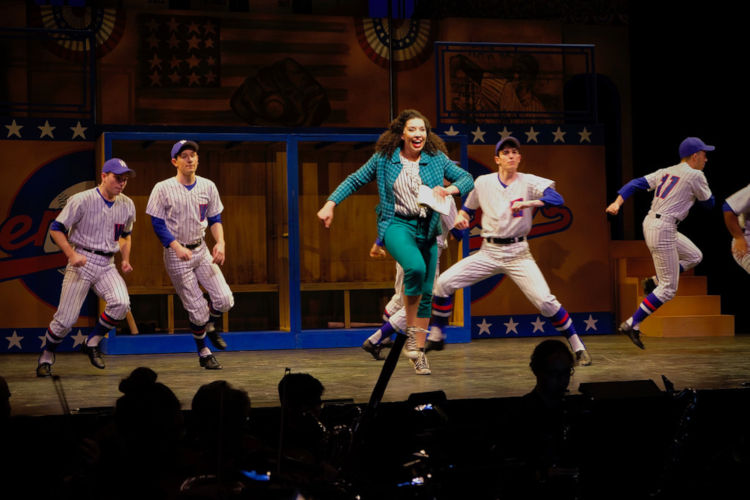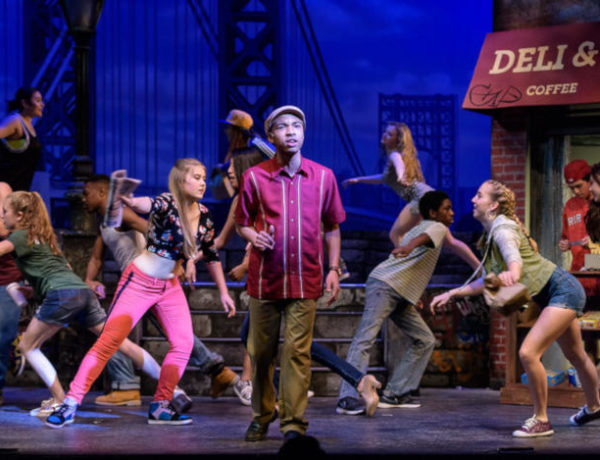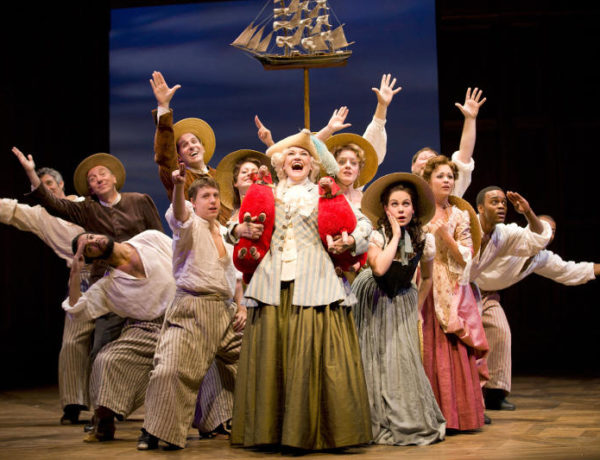Quick — stop reading, and name three musicals off the top of your head. Done? Good. We’re willing to bet that at least one of the shows that came to mind is one of the Golden Age musicals.
The Golden Age of Broadway, which started during World War II and ran through the 1950s, spawned some of the most famous musicals in the world. Composers and lyricists started working at a fast and furious pace — new musicals came out every year. In 1957 alone, the theater world was graced with Cinderella, The Music Man, and West Side Story.
Looking for a specific type of classic musical? Jump to:
Many of these classic musicals are still going strong today. They’re staples with professional and community theaters — you’ve probably watched or performed in more than a few!
Top image by Mark Mineart, courtesy of Otterbein University Theatre & Dance under CC BY-SA 2.0
Popular Golden Age Musicals
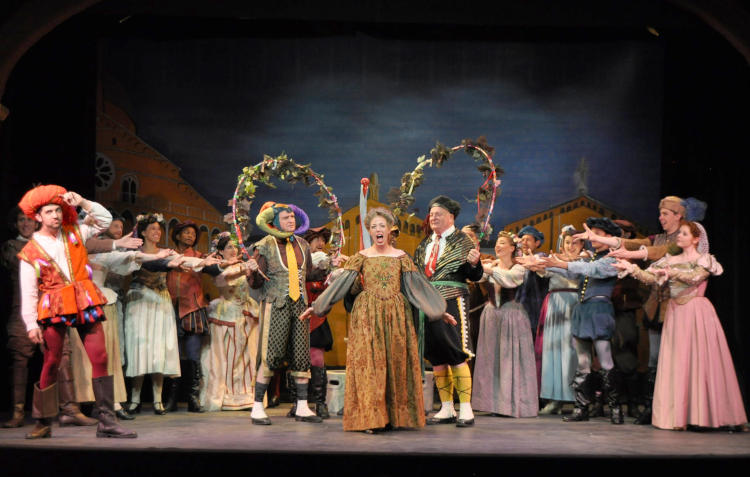
The best Golden Age musicals have one thing in common: they’re so singable. These are the kinds of musicals where you walk out of the theater singing. (Is there anything better than that kind of joy?)
1. The Sound of Music
Is there a more famous musical than The Sound of Music? It’s one of the classic musicals for high schools, community theaters, colleges, and professional companies. In fact, there are nearly 100 productions scheduled to open in the first half of 2022 alone! The story is timeless: novice nun Maria is sent to be the governess for the seven children of a widower. It has singing nuns, matching outfits, and Nazis.
Year: 1959
Music: Richard Rodgers
Lyrics: Oscar Hammerstein II
Book: Howard Lindsay, Russel Crouse
Licensing: Concord Theatricals
2. My Fair Lady
A down-on-her-luck flower seller gets an introduction into the world of high society in this lovely musical. Eliza is the perfect leading lady — she’s feisty, smart, and independent. In recent productions, including the 2018 Broadway revival, she even gets a more modern ending. (Which, despite some howling from so-called purists, is actually true to Pygmalion, the source material for the musical.)
Year: 1956
Music: Fredrick Loewe
Book and Lyrics: Alan Jay Lerner
Licensing: Concord Theatricals
3. Cinderella
Cinderella stands alone in the Rodgers and Hammerstein musicals — it’s the only one that wasn’t written for the stage. Instead, the famous duo wrote it specifically for Julie Andrews to perform live on CBS. If you want to produce the stage musical, you can choose from three full-length versions and a short youth version.
Year: 1957
Music: Richard Rodgers
Book and Lyrics: Oscar Hammerstein II
Licensing: Concord Theatricals
4. The Music Man
A charming con man steals the hearts (and the money) of the people of River City, Iowa, in this classic Golden Age musical. The music is irresistible — you’ll be singing “Goodnight My Someone” at intermission — and there’s plenty of dancing. Add in the brass-heavy orchestra score, and you have the perfect old-world Americana vision. The most recent Broadway revival opened in February of 2022, starring Hugh Jackman and Sutton Foster.
Year: 1957
Book, Music, and Lyrics: Meredith Wilson
Licensing: MTI
5. West Side Story
Star-crossed lovers meet in the midst of a dance-heavy gang war in West Side Story. It’s one of the most complex musicals of the Golden Age, both in terms of lyrics and music. (Bernstein and Sondheim? Come on.) The story is based on Romeo and Juliet and set on the streets of New York. Unlike most musicals of the time, this one doesn’t have a happy ending.
Year: 1957
Music: Leonard Bernstein
Lyrics: Stephen Sondheim
Book: Arthur Laurents
Licensing: MTI
6. Oklahoma!
Oklahoma! is the quintessential American musical, for good or for ill. Everyone has their own opinion about the show itself (Just when you think it’s over, surprise — it’s not!), but there’s no doubt that it set the tone for all of the Golden Age musicals to come. In fact, author Thomas Hischak goes so far as to call it “the single most influential work in the American musical theatre.” The story focuses on two men competing for the heart of Laurey, a feisty farm girl. This is one of those musicals where you need a powerful leading man, because the leading lady has surprisingly few scenes.
Year: 1943
Music: Richard Rodgers
Book and Lyrics: Oscar Hammerstein II
Licensing: Concord Theatricals
7. Carousel
Carousel might be the most challenging and complex musical in the Rodgers and Hammerstein empire. The story doesn’t gloss over the difficult plot points and the ensuing heartbreak; this is not a fluffy or frothy show. The music is just as beautiful as you’d expect (maybe more), and if you can find an exceptional baritone to tame the beast of “Soliloquy,” it will bring down the house.
Year: 1945
Music: Richard Rodgers
Book and Lyrics: Oscar Hammerstein II
Licensing: Concord Theatricals
8. Annie Get Your Gun
By modern standards, Annie Get Your Gun is one of the more problematic Golden Age musicals. Unlike many shows from that period, it’s not all because of the male-female power dynamic — Annie Oakley can hold her own. Rather, the issue stems from the Native American characters, who are reduced to caricatures. The music, written by Irving Berlin, is spectacular, which makes the show worth producing. That means that contemporary productions need to find a solution that’s palatable for modern audiences. Most opt to produce Peter Stone’s version which cuts the song, “I’m an Indian, Too” (yes, it’s as cringeworthy as you’d imagine).
Year: 1946
Music and Lyrics: Irving Berlin
Book: Herbert Fields and Dorothy Fields
Licensing: Concord Theatricals
9. Brigadoon
If you’ve ever been hiking in the Highlands of Scotland, you understand the beguiling blend of magic and mystery. In other words, it’s the perfect setting for Brigadoon, a Lerner and Loewe musical about two American men who are transported through time to a curious village. The love story and the Scottish influence make for an impossibly charming combination.
Year: 1947
Music: Frederick Loewe
Book and Lyrics: Alan Jay Lerner
Licensing: MTI
10. Kiss Me, Kate
Cole Porter meets Shakespeare in Kiss Me, Kate, a musical based on The Taming of the Shrew. If you tire of the saccharine nature of many musicals from the Golden Age, Kate is a fun change of pace. Songs like “I Hate Men” and “Tom, Dick, or Harry” add a fun, irreverent edge. Don’t worry — there’s plenty of romance and dancing, too.
Year: 1948
Music and Lyrics: Cole Porter
Book: Bella and Samuel Spewack
Licensing: Concord Theatricals
11. South Pacific
In South Pacific, Rodgers and Hammerstein take a distinct stand against racial bias — and still manage to retain their signature style. It’s the 1940s, and American troops and nurses are stationed on an island in the South Pacific during World War II. South Pacific focuses on the goings-on of a military post on one island. Romances and hijinks ensue, and two of the main characters (Nellie and Joe) must face and reckon with their prejudice. The combination of social commentary and musical theater was a winner; South Pacific swept the Tony awards in 1950.
Year: 1949
Music: Richard Rodgers
Lyrics: Oscar Hammerstein II
Book: Oscar Hammerstein II, Joshua Logan
Licensing: Concord Theatricals
12. Guys and Dolls
Gamblers, missionaries, and showgirls come together in this classic musical, which is one of the most popular of all time. In fact, it’s often called the perfect musical. Free-wheeling card player Sky Masterson falls in love with Sarah Brown, an idealistic young missionary, and chaos ensues. You’ll recognize many of the songs — “Luck, Be a Lady,” “If I Were a Bell, ” and “Sit Down, You’re Rocking the Boat” are just a few of the hits.
Year: 1950
Music and Lyrics: Frank Loesser
Book: Abe Burrows, Jo Swerling
Licensing: MTI
13. The King and I
Just two years after their triumph at the Tonys with South Pacific, Rodgers and Hammerstein did it again — this time, with The King and I. A British teacher arrives in Siam (now Bangkok) to teach the royal children, and finds herself navigating an uneasy friendship with the king. The plot is based on the real-life adventures of Anna Leonowens, but takes some artistic liberties. Although Rodgers and Hammerstein were initially hesitant to write the show, it ended up winning the Tony for Best Musical in 1952.
Year: 1951
Music: Richard Rodgers
Book and Lyrics: Oscar Hammerstein II
Licensing: Concord Theatricals
14. Singin’ In the Rain
We don’t often talk about movie musicals that are turned into successful stage musicals, but Singin’ In the Rain is one we love. The 1952 movie starred Gene Kelly and Debbie Reynolds; it wasn’t made into a stage musical until 1983. The plot follows Hollywood performers navigating the change from silent films to “talkies” in the 1920s. Packed with tap dancing and hits like “Good Morning” and “Singin’ in the Rain,” it’s impossible not to love.
Year: 1952
Music: Arthur Freed, Nacio Herb Brown
Screenplay: Betty Comden, Adolph Green
Licensing: MTI
15. The Wizard of Oz
The Wizard of Oz isn’t technically a Golden Age musical — it came out in 1939 — but it’s certainly one of the most popular classic musicals. You know the story: Dorothy Gale is caught up in a tornado, and arrives in the magical land of Oz. She sets out on a journey with the Tin Man, Cowardly Lion, and Scarecrow, encountering witches and other creatures along the way.
Year: 1939
Music and Lyrics: Harold Arlen and E. Y. Harburg, Herbert Stothart
Book: L. Frank Baum
Licensing: Concord Theatricals (MUNY Version)
16. Meet Me in St. Louis
Here’s another gorgeous Golden Age musical that got its start as a movie starring Judy Garland. Released in 1944, it takes audience members through a year with the Smith family at the turn of the century. If you don’t know the show, you probably know two of its big musical numbers: “Have Yourself a Merry Little Christmas” and “The Trolley Song.” While the movie was a hit, the stage musical didn’t come out until 1989.
Year: 1944
Music and Lyrics: Hugh Martin & Ralph Blane
Book: Hugh Wheeler
Licensing: Concord Theatricals
17. Irving Berlin’s White Christmas
We’re on a roll — White Christmas is another classic movie musical turned stage musical. World War II is over, and former soldiers Bob Wallace and Phil Davis have created a thriving performing career. When they discover that their former commander is in trouble, they mount a Christmas show to help him out. The Irving Berlin score is the star of the show; it sparkles with hits like “White Christmas,” “Sisters,” and “Count Your Blessings Instead of Sheep.”
Year: 1954
Music and Lyrics: Irving Berlin
Book: David Ives, Paul Blake
Licensing: Concord Theatricals
18. Show Boat
Show Boat is arguably the most famous Golden Age musical…or at least it was in decades past. The epic plot spans 40 years, following the lives of the people on a show boat on the Mississippi River. With songs like “Ol’ Man River” and “Can’t Help Lovin’ Dat Man,” this musical demands big voices and serious talent.
Year: 1927
Music: Jerome Kern
Lyrics: Oscar Hammerstein II
Licensing: Concord Theatricals
19. On the Town
Three sailors enjoy a day on the town in this irresistible musical. Leonard Bernstein wrote the music, so you know it’s going to be good. “Exuberant” might be the best way to describe the show — it’s happy and full of life. As with most Bernstein shows, it’s also a big vocal challenge, in the best way possible.
Year: 1944
Music: Leonard Bernstein
Book and Lyrics: Betty Comden, Adolph Green
Licensing: Concord Theatricals
20. Wonderful Town
Wonderful Town is another delicious Leonard Bernstein musical. (Just listen to Audra McDonald in this clip or Donna Murphy in this one.) Two sisters leave Ohio and move to New York in the mid-1930s, hoping to make it big as performers in the big city. This show isn’t performed often, but the music is downright spectacular. It also has some of the best non-ballad songs for women in the entire musical theater canon.
Year: 1953
Music: Leonard Bernstein
Lyrics: Betty Comden, Adolph Green
Book: Joseph Fields, Jerome Chodorov
Licensing: Concord Theatricals
21. The Pajama Game
The Pajama Game came out in the middle of the Golden Age, but it has a decidedly different sound — it reflects the pop sound of the era. It’s easy to imagine Frank Sinatra singing “Hey There.” Set in a pajama factory, the plot is a classic romance between two headstrong characters. This musical has some excellent, underappreciated pieces; we love “There Once Was a Man,” in particular.
Year: 1954
Music and Lyrics: Richard Adler, Jerry Ross
Book: George Abbott, Richard Bissell
Licensing: MTI
22. Damn Yankees
Damn Yankees is one of those gorgeous Golden Age musicals that isn’t performed nearly enough. The story stands alone in musical theater — an aging baseball player makes a deal with the devil to be young again and lead his team to victory. (It’s based on Douglass Wallop’s book The Year the Yankees Lost the Pennant) The score is stunning and remarkably diverse; listen to “Goodbye Old Girl,” “Shoeless Joe From Hannibal, MO,” and “Two Lost Souls,” and you’ll see what we mean.
Year: 1955
Music and Lyrics: Jerry Ross, Richard Adler
Book: Douglass Wallop, George Abbott
Licensing: MTI
23. Candide
Candide is technically a Golden Age operetta, but we’re going to let that slide — we love Leonard Bernstein, after all. Plus, songs like “The Best of All Possible Worlds” have a distinct musical-theater vibe. If you have a group of capable singers, there are few ensemble numbers that can beat the finale, “Make Our Garden Grow.” Get it right, and it reverberates off the walls of the theater, leaving your audience breathless. (Listen to this recording around 3:20)
Year: 1956
Music: Leonard Bernstein
Lyrics: Richard Wilbur
Book: Hugh Wheeler, John Caird
Licensing: MTI
24. Gypsy
Finally, a musical with a low-voiced leading lady! The role of Mama Rose was written for Ethel Merman, which explains this shift from the typical classic musical casting patterns. The plot tells the story of the stripper, Gypsy Rose Lee, and her mother — the ultimate stage mom. This is another show people like to call the perfect musical, but we’ll leave that decision up to you.
Year: 1959
Music: Jule Styne
Lyrics: Stephen Sondheim
Book: Arthur Laurents
Licensing: Concord Theatricals
25. Once Upon a Mattress
Once Upon a Mattress is a delightfully weird little musical that gives a classic fairy tale a bit of a twist. Princess Winnifred, our heroine, isn’t a delicate flower who needs to be rescued — quite the opposite, in fact. But to get her prince, she’ll need to contend with a conniving queen and a host of townsfolk. Loosely based on The Princess and the Pea, this musical is fun to watch and perform. (If you’re an actor, you know that’s not always the case.)
Year: 1958
Music: Mary Rodgers
Lyrics: Marshall Barer
Book: Jay Thompson, Marshall Barer, Dean Fuller
Licensing: Concord Theatricals
26. Seven Brides for Seven Brothers
When you need a musical with a big cast, Seven Brides for Seven Brothers is a great choice. Set in Oregon during the days of westward expansion, this lighthearted musical offers a vintage peek at women’s empowerment. The story feels familiar, but the songs aren’t well-known — the perfect way to comfort and surprise your audience at the same time.
Year: 1954
Music: Gene dePaul
Lyrics: Johnny Mercer
Book: Lawrence Kasha, David Landay
Licensing: MTI
Lesser-Known Classic Musicals from the Golden Age
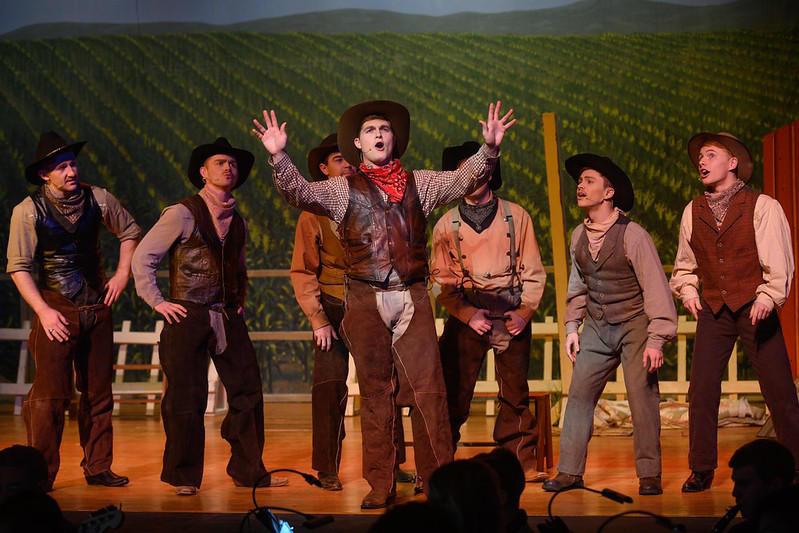
If you love the Golden Age style, but you’re looking for something a little less done, we have your back. There are plenty of classic musicals that don’t get as much stage time.
27. Pipe Dream
Well, what do you know — it’s Rodgers and Hammerstein! Pipe Dream is proof that this prolific duo wasn’t immune to the occasional non-hit. The plot comes from a book John Steinbeck wrote specifically with a musical adaptation in mind (unexpected). World War II has ended, and Suzy, a prostitute, falls in love with Doc, a marine biologist. Both Rodgers and Hammerstein were uncomfortable with Suzy’s profession; they reduced it to vague references, irritating Steinbeck in the process. Despite its negative reviews, Pipe Dream played for 245 performances, and gave us songs like “Everybody’s Got a Home But Me.”
Year: 1955
Music: Richard Rodgers
Book and Lyrics: Oscar Hammerstein II
Licensing: Concord Theatricals
28. Pal Joey
Most classic musicals feature a pure-hearted hero. Pal Joey does not — its leading man is a womanizer and a bit of a con artist. He’s likable, of course, and uses that charm to woo a married woman and a younger, more naive woman. It doesn’t go well for him, but Joey is nothing if not a survivor. If you’ve watched many musicals from the Golden Age, you’ll notice the difference in subject matter. Audiences at the time did, too; even with Gene Kelly as Joey, reviews were mixed.
Year: 1940
Music: Richard Rodgers
Lyrics: Lorenz Hart
Book: John O’Hara
Licensing: Concord Theatricals
29. Bells Are Ringing
Altos and mezzos, rejoice — Bells Are Ringing offers two things you rarely see in musical theater. The starring role doesn’t sing higher than C5, so the songs settle easily into a lower voice. Plus, she’s funny. The plot follows Ella Peterson, a switchboard operator with a taste for gossip. In one show, Ella gets to sing “The Party’s Over” and “It’s a Perfect Relationship.” We’d love to see this show produced more often!
Year: 1956
Music: Jule Styne
Book and Lyrics: Betty Comden, Adolph Green
Licensing: Concord Theatricals
30. Little Mary Sunshine
Little Mary Sunshine is a send-up of popular operettas from the 1930s and 1940s — but the music is easy to love, even if you’re not up on the references. The score is fun and frothy, and you can’t go wrong with the Wild West setting. A Colorado ranger falls in love with Mary, the owner of an inn. To complicate matters, the inn is sitting on land that’s contested by the government and the local Native American tribe. This musical is challenging (if not impossible) to perform for modern audiences, largely because of the way the Native American characters are represented. A workshop production in the early 2000s tried to update the script with the help of a Lakota consultant, but the show never made it to the stage.
Year: 1959
Music, Book, and Lyrics: Rick Besoyan
Licensing: Concord Theatricals
31. Flower Drum Song
In 1957, author C.Y. Lee wrote the novel The Flower Drum Song about the struggles and joys of Chinese immigrants as they attempt (or refuse to) assimilate to their new lives in San Francisco. Rodgers and Hammerstein agreed to adapt the book into a musical; it was a hit, running for 600 performances on Broadway. As you might guess, the original script was flawed — so in 1997, the Rodgers & Hammerstein organization and C.Y. Lee approved a rewrite by playwright David Henry Hwang. This version removed some of the harmful stereotypes and gave the female characters more agency. Despite the updates and a successful run in Los Angeles, the show failed on Broadway.
Year: 1958
Music: Richard Rodgers
Lyrics: Oscar Hammerstein II
Book: Oscar Hammerstein II, Joseph Fields, David Henry Hwang
Licensing: Concord Theatricals | 2002 Hwang version
32. Something for the Boys
Something for the Boys is one of Cole Porter’s least-known musicals. It tells the story of the three Hart cousins, who have inherited a ranch in Texas. As they get to know each other and decide what to do with their new property, they make an enemy of the local lieutenant. The score is fun and singable — it is Cole Porter, after all. This musical isn’t available for licensing, largely because the original materials weren’t preserved, but you can listen to the 2018 recording on YouTube or hunt down the 1944 film version (trailer).
Year: 1943
Music and Lyrics: Cole Porter
Book: Dorothy Fields, Herbert Fields
Licensing: Not available
33. Finian’s Rainbow
Two Irish immigrants move to the United States and bury a pot of gold — and naturally, that escapade gets them mixed up with a leprechaun and a money-hungry senator. The music has a charming Irish twist, and the story is packed with fun characters. It’s got everything you need for a Golden Age hit, but you probably won’t see many productions; as with many shows from the time, the script is loaded with racial prejudice that’s hard to eliminate. We’d love to see someone figure out how to eliminate the bad and keep the good; the story has a lot to say about race and power dynamics.
Year: 1947
Music: Burton Lane
Lyrics: E.Y. Harburg, Fred Saidy
Book: E.Y. Harburg
Licensing: Concord Theatricals
34. By Jupiter
An army of Greek warriors arrive in the territory of the Amazons, hoping to steal the Sacred Girdle of Diana. A land ruled by women is so shocking to the men that they’re captured. Of course, everyone ends up getting along in the end. This weird little show was popular in the 1940s; the simplistic stereotypes seem tired and trite today.
Year: 1942
Music: Richard Rodgers
Lyrics: Lorenz Hart
Book: Richard Rodgers, Lorenz Hart
Licensing: Concord Theatricals
35. Song of Norway
This strange little operetta follows the life of Edvard Grieg, using Grieg’s own music. Unsurprisingly, the orchestration is better than most of the vocal lines (though there are some glorious moments in “The Song of Norway” and “Hill of Dreams”). Song of Norway was well-received on Broadway, playing for nearly two years; it was made into a movie in 1970. You can watch the whole thing on YouTube — it’s a lovely reminder that before Florence Henderson was Carol Brady, she was an exceptional singer.
Year: 1944
Music and Lyrics: Edvard Grieg, Robert Wright, George Forest
Book: Milton Lazarus
Licensing: Concord Theatricals
36. Lost in the Stars
Lost in the Stars offers a glimpse into South Africa in the late 1940s. Based on Alan Paton’s book Cry, the Beloved Country, the plot follows Reverend Stephen Kumalo as he deals with the consequences of his wayward son’s actions. Kumalo deals with faith, race, murder, and family in this heartbreaking musical, which ends with both grief and hope.
Year: 1949
Music: Kurt Weill
Book and Lyrics: Maxwell Anderson
Licensing: Kurt Weill Foundation for Music
37. The Boy Friend
The Roaring 20s are going strong, and Polly is on a quest to find a boyfriend. Her father is convinced that no one is good enough for his daughter — she is an heiress, after all — but Polly is determined. Naturally, she falls in love anyway, and everyone lives happily ever after. The stakes are delightfully low, the music is bright and charming, and you’re certain to walk away smiling. If you need a musical for a large cast, this is a lovely option; there are lots of fun ensemble numbers.
Year: 1953
Book, music, and lyrics: Sandy Wilson
Licensing: MTI
38. Paint Your Wagon
Get ready for some Gold Rush fun in Paint Your Wagon. A father and his daughter, Jennifer, move to California, hoping to strike it rich in the gold mines; they succeed, and a bustling, all-male mining town grows around their claim. Jennifer falls in love with a local Mexican priest, and must deal with the realities of the Wild West, class, and race. This musical has a distinct vintage sound that’s reminiscent of the early part of the Golden Age — but it came out in 1951.
Year: 1951
Music: Frederick Loewe
Book and lyrics: Alan Jay Lerner
Licensing: MTI
39. High Button Shoes
Two con men have swindled the Longstreet family — and worse, young Fran has run away with the crooks to Atlantic City! It’s all very shocking; naturally, the family must chase the trio to retrieve Fran and restore their honor. Chaos erupts, and the legendary chase scene/dance number (“The Bathing Beauty Ballet”) ensues. The music is charming (if forgettable), and you won’t find a more adorable, likable musical.
Year: 1947
Music: Jule Styne
Lyrics: Sammy Cahn
Book: Stephen Longstreet
Licensing: Concord Theatricals
40. Where’s Charley?
The year is 1892, and Oxford University seniors Charley and Jack are looking forward to an afternoon with their girlfriends. Everything goes awry when Charley’s aunt doesn’t show up to chaperone — so to save the day, Charley dresses up like his aunt. Everything goes smoothly, until the girls’ guardian falls in love with “Charley’s aunt.” This musical farce, which is based on the play Charley’s Aunt, is loaded with mistaken identities and fun, upbeat Frank Loesser songs.
Year: 1948
Music and lyrics: Frank Loesser
Book: George Abbott (based on Brandon Thomas’ play)
Licensing: MTI
41. Allegro
If you love Rodgers and Hammerstein, but you’re looking for a different twist on the Golden Age musical, Allegro is worth a look. The music has that R&H charm, so it feels pleasantly familiar even if audiences don’t know the show (and they probably won’t). Over the course of 2 hours, you’ll watch Joseph Taylor, Jr. experience the joys and trials of life from birth to age 35 in a series of vignettes, with commentary by a Greek chorus — it was an extremely unusual offering for the 1940s. Audiences at the time thought it was a little too preachy, and it flopped. (But also, it came immediately after Oklahoma! and Carousel, so expectations were high.)
Year: 1947
Music: Richard Rodgers
Book and lyrics: Oscar Hammerstein II
Licensing: Concord Theatricals
42. Miss Liberty
With its impossibly melodic Irving Berlin score, Miss Liberty is all joy — and it’s a good thing, because critics were ambivalent about the plot. This Berlin musical tells the story of a reporter who goes in search of the model who posed for Frédéric Auguste Bartholdi as he designed the Statue of Liberty. He heads to Paris, locates the model, and falls in love…only to discover that he has the wrong woman. It’s a shame this one isn’t performed more often for the breathtaking ensemble finale (“Give Me Your Tired, Your Poor“).
Year: 1949
Music and lyrics: Irving Berlin
Book: Robert E. Sherwood
Licensing: Concord Theatricals
43. Call Me Madam
Here’s another rarely performed Irving Berlin gem — Call Me Madam is a delight for the audience and the performers. Plus, it has a lower-voiced, non-ingenue leading lady. (It was originated by Ethel Merman; Tyne Daly performed the role in a 1995 revival.) The story follows a minimally qualified female ambassador as she stumbles through her new role in a tiny European country, eventually charming everyone. The story is based on the real-life adventures of Perle Mesta, who served in a similar role in Luxembourg in 1949.
Year: 1950
Music and lyrics: Irving Berlin
Book: Howard Lindsay, Russel Crouse
Licensing: Concord Theatricals
44. A Tree Grows in Brooklyn
Based on the Betty Smith book of the same name, A Tree Grows in Brooklyn has similar themes as the more successful Carousel — a woman marries a drunk, he fails to change, she bears the burden of their working-class life, he dies. Despite its beautiful score (especially this song), this musical wasn’t a success; the original production team shifted the script to showcase Shirley Booth’s comedic talents, and it wound up detracting from the story. If you can get your hands on the original cast album, it’s worth a listen!
Year: 1951
Music: Arthur Schwartz
Lyrics: Dorothy Fields
Book: George Abbott, Betty Smith
Licensing: Not available
45. Flahooley
Here’s another delightful Golden Age flop from 1951 — again, with a lovely score. Flahooley is a convoluted musical that’s (loosely) about a toymaker, a doll, and a genie, with a not-so-small splash of social commentary (anti-McCarthyism, anyone?) thrown in for good measure. Harburg used the musical to take a swing at the blacklisting that was happening in Hollywood. (Check out Mark Robinson’s interesting historical take.) We love the not-subtle song “You Too Can Be a Puppet,” which was directed at McCarthy’s followers. (Sadly, it’s still applicable.) We can’t help but wonder if, 10 years later, the How to Succeed team was inspired by the lyric, “join the brother-wood of man.”
Year: 1951
Music: Sammy Fain
Book and lyrics: E. Y. Harburg
Licensing: Yip Harburg Foundation
46. The Golden Apple
Do you ever wonder what Homer would think if he knew the impact his work would have on the world of theater? The Golden Apple is a jaunty, brass-heavy musical adaptation of the Iliad and Odyssey — one only the Golden Age could produce. (As Ulysses comes home from battle, he sings, “It Was a Glad Adventure.”) The show is sung through; we’d love to see it performed more by college or community theater groups.
Year: 1954
Music: Jerome Moross
Book and lyrics: John Treville Latouche
Licensing: Concord Theatricals
47. By the Beautiful Sea
A Vaudeville star and a shady Shakespearean actor fall in love in By the Beautiful Sea. Set on Coney Island in 1907, this musical is a set/costume designer’s dream. It’s frothy and fun, with a few lovely, soaring songs tossed in for good measure (baritone friends, check out “Lottie’s Alone”). It’s mostly charming, with the big fat exception of one song — “Old Enough to Love” — which is straight-up creepy.
Year: 1954
Music: Arthur Schwartz
Lyrics: Dorothy Fields
Book: Dorothy Fields, Herbert Fields
Licensing: MTI
48. Top Banana
There aren’t many women in this Golden Age musical; it’s a dude-heavy show that tells the story of Jerry Biffle, a TV host who falls in love with a model named Sally. Unfortunately for Jerry, Sally falls in love with a golden-voiced tenor named Cliff. The role of Jerry was written for the legendary comedian Phil Silvers, so it’s packed with zany jokes and physical comedy. (Take a look at the cover art for the cast recording; you’ll get the vibe.) And let us know if you see anyone producing the show — we’d love to see it live!
Year: 1951
Music and Lyrics: Johnny Mercer
Book: Hy S. Kraft
Licensing: Concord Theatricals
49. Me and Juliet
It seems only fitting to close out our list with the kings of the Golden Age. Me and Juliet is one of Rodgers and Hammerstein’s rare non-hits. If you’re a theater kid at heart, you can’t help but love the premise — it’s a show-within-a-show about a cast-crew showmance. If you can get your hands on the book, note how it steers clear of common backstage tropes; this was the duo’s attempt to set the show apart from other backstage musicals. Though the show wasn’t a wild success, it did give us songs like “No Other Love.”
Year: 1953
Music: Richard Rodgers
Book and Lyrics: Oscar Hammerstein II
Licensing: Concord Theatricals
When Was the Golden Age of Broadway?
Theater historians generally agree that the Golden Age of Broadway started in 1943 with Rodgers and Hammerstein’s Oklahoma and ran until 1959. There’s some flexibility; most people consider the entire 1940s decade to be part of this period in the American musical theater.
Why Was It Called the Golden Age of Broadway?
The period between 1940 and 1950 was called the “Golden Age” of Broadway because it produced a huge number of hit American musicals, thanks to superstar composers such as Rodgers and Hammerstein, Leonard Bernstein, Lerner and Loewe, Frank Loesser, and Bock and Harnick. During the Golden Age, musical theater evolved into the distinct art form we know today. It was such an influential period that Golden Age musicals are still some of the most popular shows to produce.

